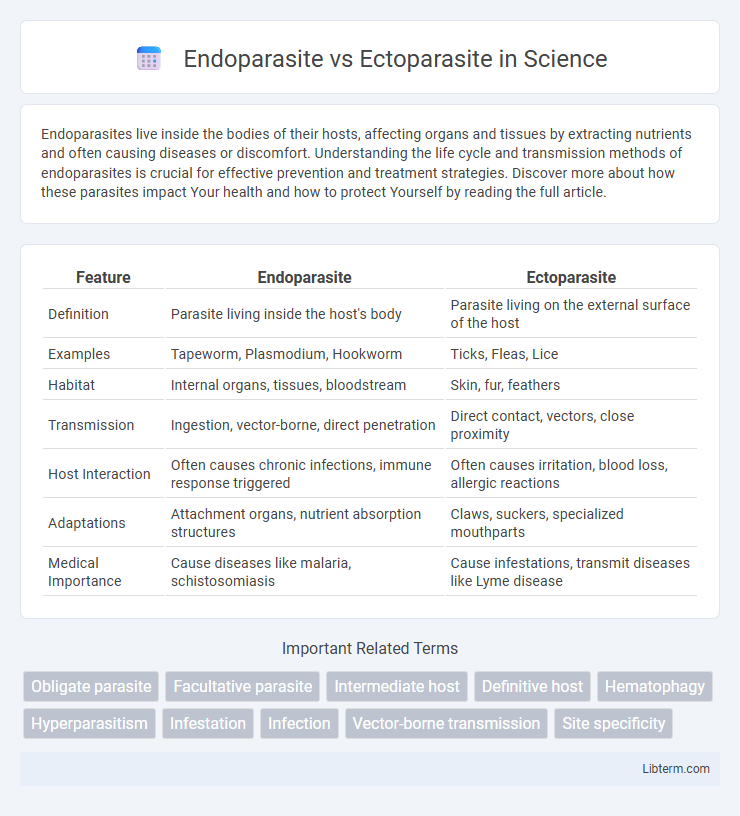Endoparasites live inside the bodies of their hosts, affecting organs and tissues by extracting nutrients and often causing diseases or discomfort. Understanding the life cycle and transmission methods of endoparasites is crucial for effective prevention and treatment strategies. Discover more about how these parasites impact Your health and how to protect Yourself by reading the full article.
Table of Comparison
| Feature | Endoparasite | Ectoparasite |
|---|---|---|
| Definition | Parasite living inside the host's body | Parasite living on the external surface of the host |
| Examples | Tapeworm, Plasmodium, Hookworm | Ticks, Fleas, Lice |
| Habitat | Internal organs, tissues, bloodstream | Skin, fur, feathers |
| Transmission | Ingestion, vector-borne, direct penetration | Direct contact, vectors, close proximity |
| Host Interaction | Often causes chronic infections, immune response triggered | Often causes irritation, blood loss, allergic reactions |
| Adaptations | Attachment organs, nutrient absorption structures | Claws, suckers, specialized mouthparts |
| Medical Importance | Cause diseases like malaria, schistosomiasis | Cause infestations, transmit diseases like Lyme disease |
Introduction to Parasites: Endoparasites vs Ectoparasites
Endoparasites inhabit the internal organs or tissues of their hosts, often causing diseases such as malaria and tapeworm infections, while ectoparasites live on the external surface, including organisms like ticks and lice that feed on blood or skin. Understanding the distinction between endoparasites and ectoparasites is crucial for diagnosing and treating parasitic infections in humans, animals, and plants. Both types impact host health by exploiting biological resources but differ in their ecological niches and modes of transmission.
Defining Endoparasites: Characteristics and Life Cycle
Endoparasites are organisms that live inside the host's body, typically within organs or tissues, deriving nutrients at the host's expense while often causing diseases. Their life cycle usually involves multiple stages, including egg, larval, and adult forms, with some requiring intermediate hosts to complete development. Adaptations such as complex reproductive strategies and immune evasion mechanisms enable endoparasites like tapeworms and protozoa to thrive and persist within internal environments.
Understanding Ectoparasites: Features and Habitats
Ectoparasites are external parasites that live on the surface of their host, such as ticks, fleas, and lice, adapting to feed on blood or skin. Their habitats include the fur, feathers, or outer skin of mammals, birds, and reptiles, enabling easy access to nutrients without entering the host's internal organs. These parasites often have specialized adaptations like claws and mouthparts for attachment and feeding on the host's external body.
Key Differences Between Endoparasites and Ectoparasites
Endoparasites live inside the host's body, targeting organs, tissues, or cells, while ectoparasites reside on the host's external surface, such as skin or hair. Endoparasites include organisms like tapeworms and roundworms, causing internal damage and nutrient depletion, whereas ectoparasites include lice, fleas, and ticks, often causing irritation and transmitting pathogens. The transmission methods, life cycles, and host interactions differ significantly, influencing diagnosis, treatment, and prevention strategies.
Common Examples of Endoparasites
Common examples of endoparasites include tapeworms, roundworms, and flukes, which inhabit internal organs such as the intestines, blood, or tissues of their hosts. These parasites often cause diseases like schistosomiasis and ascariasis in humans and animals by disrupting nutrient absorption or damaging organ systems. Unlike ectoparasites that live on the skin surface, endoparasites thrive within the host's body, making diagnosis and treatment more complex.
Notable Examples of Ectoparasites
Common notable examples of ectoparasites include ticks, fleas, lice, and mites, which infest the external surfaces of mammals, birds, and reptiles. These parasites consume host blood or skin, causing irritation and potential transmission of diseases such as Lyme disease from ticks and typhus from lice. Ectoparasites play a significant role in veterinary and medical entomology due to their impact on animal and human health worldwide.
Modes of Transmission: Endoparasites vs Ectoparasites
Endoparasites transmit primarily through ingestion of contaminated food, water, or soil containing infective eggs or larvae, often involving intermediate hosts or vectors. Ectoparasites spread mainly via direct contact between hosts or through infested environments, such as bedding or clothing, facilitating rapid attachment and blood-feeding. Understanding these distinct transmission modes is crucial for targeted prevention and control strategies in managing parasitic infestations.
Health Impacts on Hosts: Endoparasites vs Ectoparasites
Endoparasites, residing inside the host's body, often cause severe internal damage such as organ dysfunction, nutrient depletion, and systemic infections, impacting overall health and immune response. Ectoparasites, living on the host's surface, primarily cause skin irritation, allergic reactions, and can act as vectors for transmitting diseases like Lyme disease and malaria. Both parasite types significantly compromise host well-being, but endoparasites tend to have more profound internal health consequences while ectoparasites mainly affect external tissues and vector-borne disease risks.
Diagnosis and Detection Methods
Endoparasite diagnosis relies on stool examinations, blood tests, and imaging techniques like ultrasound or MRI to detect internal parasite presence, whereas ectoparasite detection primarily involves visual inspection, skin scrapings, and dermoscopy to identify external parasites such as lice, mites, or ticks. Molecular methods such as PCR enhance detection accuracy for both parasite types by identifying specific genetic markers. Serological tests also aid in diagnosing systemic responses to endoparasites, providing crucial information for effective treatment.
Prevention and Treatment Strategies for Parasitic Infections
Prevention of endoparasite infections involves regular deworming, maintaining proper hygiene, and avoiding contaminated food and water sources, while ectoparasite prevention emphasizes using insect repellents, wearing protective clothing, and keeping living areas clean to deter lice, fleas, and ticks. Treatment strategies for endoparasites typically include antiparasitic medications like albendazole and ivermectin, targeting internal worms and protozoa, whereas ectoparasite infestations are managed with topical insecticides, such as permethrin and malathion, combined with thorough environmental cleaning. Effective control relies on integrated approaches combining pharmaceutical intervention and environmental management to reduce reinfestation risks for both parasite types.
Endoparasite Infographic

 libterm.com
libterm.com